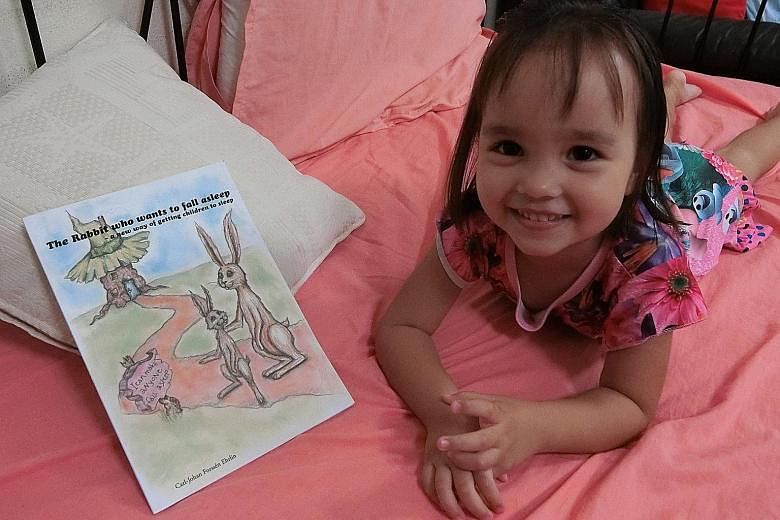My daughter Leah is sometimes bright-eyed and bushy-tailed at 11pm.
Her elder brother Micah, six, is usually tucked in by 9pm, apparently finding our bedtime routine of showering, stories and prayers uncontroversial.
In contrast, Leah, who is almost three, hijacks bedtime with marathon reading requests or pleas to play Lego princesses together.
My husband and I go along as it's the path of least resistance after reading Where Is The Green Sheep? seven times. We cling to the hope that each request will be the last and that all kids get tired sometimes and eventually fall asleep at night.
Also, my hissing "please go to sleep" doesn't work, surprisingly.
The thing is, some days, Leah goes to bed without fuss at 8pm. It is with a view to taking the randomness out of this process that I looked forward to testing out The Rabbit Who Wants To Fall Asleep.
The book features deliberate hit- and-miss capitalisation - the front cover has a signboard that says "I can make aNyoNe faLL asleep". This is mildly disturbing for a grammar nerd like me, but I shrug it off.
Believed to be the first self- published book to top Amazon's charts, the book is devised by a Swedish psychologist, Carl-Johan Forssen Ehrlin. In search of slumber, Roger the insomniac bunny goes with Mommy Rabbit to visit sleep wizard Uncle Yawn, getting advice from Sleepy Snail and Heavy-Eyed Owl along the way.
Parents are encouraged to emphasise certain words and read other, italicised phrases with "a slow and calm voice", as well as yawn when reading the tale.
The instructions do not inspire confidence, accompanied as they are by a "warning!": "Never read this book out loud close to someone driving any type of vehicle."
A sense of unease grows within me with the disclaimer: "Even if this book is harmless to use, the author and publisher takes no responsibility for the outcome."
Parents are also told that the name of the rabbit, Roger, "can be read as Rooo geeer with two yawns".
Call me a pedant, but is the last syllable just drawn out or is the name now pronounced Rooo-gear?
I set aside these reservations and start reading the story to Leah, "Rooo-geeer-ing" along the way.
She soon gets restive and starts doing a backward roll on the bed. She has had enough by the third page, where Roger is pictured talking to Sleepy Snail, who has an unflattering Papa Smurf-esque beard, presumably to convey wisdom in the realms of slumber.
She proclaims the story "lousy" and later clamps her hands over my mouth, giggling, while I doggedly read on. She tries to get me to draw her a house and tie her hair.
I don't blame her. The heavy- handed tale is peppered with phrases such as "fall asleep now", "goodnight" and "It's important that you do as I tell you and just relax".
It would be sinister if it weren't laughable. The story reads like a cheesy attempt at sleep hypnosis. I might as well have tried waving a hypnosis spiral at my daughter and am relieved that she didn't take to this frankly boring tale.
The skimpy plot also makes the unexpectedly slim volume feel too long. I take about half an hour to finish reading, orchestrated yawns and all. Leah hasn't fallen asleep during the course of it despite its author's claims and positive reviews of the book's efficacy online.
Leah and I will go for other books. At least she might gain a love of reading, as we stay up into the wee hours.


